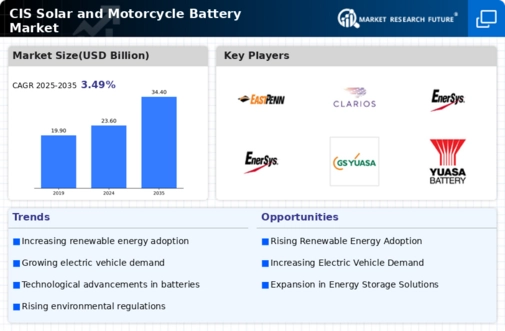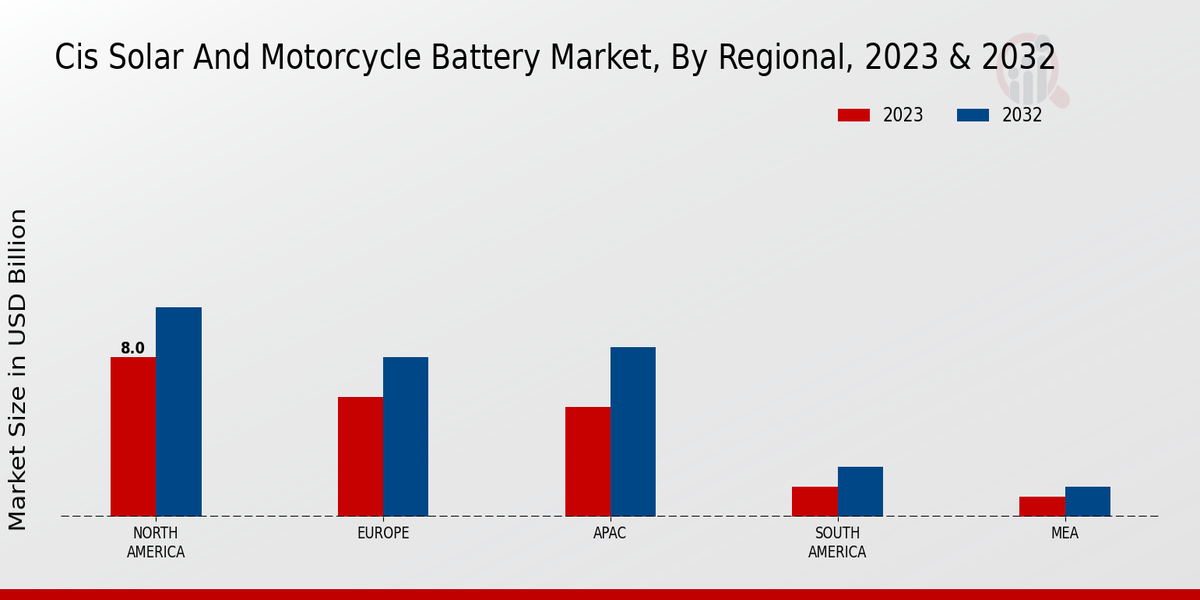Market Growth Projections
The Global CIS Solar and Motorcycle Battery Market Industry is poised for substantial growth in the coming years. Projections indicate that the market will reach 23.6 USD Billion in 2024 and is expected to expand to 34.4 USD Billion by 2035. This growth trajectory suggests a compound annual growth rate (CAGR) of 3.49% from 2025 to 2035. Such figures reflect the increasing integration of solar technologies and advanced battery systems in various applications, including residential, commercial, and transportation sectors. The anticipated growth underscores the importance of innovation and investment in renewable energy solutions as the world transitions towards a more sustainable future.
Rising Electric Vehicle Adoption
The surge in electric vehicle (EV) adoption is a significant catalyst for the Global CIS Solar and Motorcycle Battery Market Industry. As consumers increasingly opt for electric motorcycles and scooters, the demand for high-performance batteries is expected to rise. This trend is supported by government incentives and initiatives aimed at promoting electric mobility. With the global motorcycle battery market projected to expand alongside the EV sector, manufacturers are likely to focus on developing batteries that meet the specific needs of electric motorcycles. This shift not only enhances the market landscape but also aligns with broader sustainability goals, potentially increasing market value to 34.4 USD Billion by 2035.
Advancements in Battery Technology
Technological innovations in battery design and performance are significantly influencing the Global CIS Solar and Motorcycle Battery Market Industry. Recent developments in lithium-ion and solid-state batteries have improved energy density, charging speed, and lifespan, making them more appealing to consumers. For example, advancements in battery management systems enhance the efficiency and safety of motorcycle batteries, which is crucial for electric motorcycles gaining popularity. As these technologies evolve, they are expected to drive market growth, with projections indicating a compound annual growth rate (CAGR) of 3.49% from 2025 to 2035. This growth reflects the increasing reliance on advanced battery systems in various applications.
Growing Demand for Renewable Energy
The increasing global emphasis on renewable energy sources is a primary driver for the Global CIS Solar and Motorcycle Battery Market Industry. Governments worldwide are implementing policies to reduce carbon emissions and promote sustainable energy solutions. For instance, the global solar energy market is projected to reach 23.6 USD Billion in 2024, reflecting a robust shift towards solar technologies. This trend is likely to enhance the demand for CIS solar panels, which are known for their efficiency and cost-effectiveness. As more consumers and businesses adopt solar energy, the need for reliable battery storage solutions will also rise, further propelling market growth.
Government Incentives and Regulations
Government policies and incentives play a crucial role in shaping the Global CIS Solar and Motorcycle Battery Market Industry. Many countries are implementing regulations that encourage the use of renewable energy and electric vehicles. Subsidies, tax credits, and grants for solar installations and electric motorcycle purchases are becoming more common. These initiatives not only lower the financial barriers for consumers but also stimulate market growth by increasing the adoption of solar technologies and electric motorcycles. As governments continue to prioritize sustainability, the market is likely to experience accelerated growth, driven by favorable regulatory environments and financial support.
Increased Awareness of Environmental Issues
The growing awareness of environmental issues among consumers is driving the Global CIS Solar and Motorcycle Battery Market Industry. As individuals become more conscious of their carbon footprints, there is a noticeable shift towards sustainable energy solutions. This trend is evident in the rising interest in solar energy and electric motorcycles, both of which contribute to reduced emissions. Companies are responding to this demand by developing eco-friendly products and marketing them to environmentally conscious consumers. This shift in consumer behavior is likely to sustain market growth, as more people seek alternatives that align with their values and contribute to a healthier planet.




















